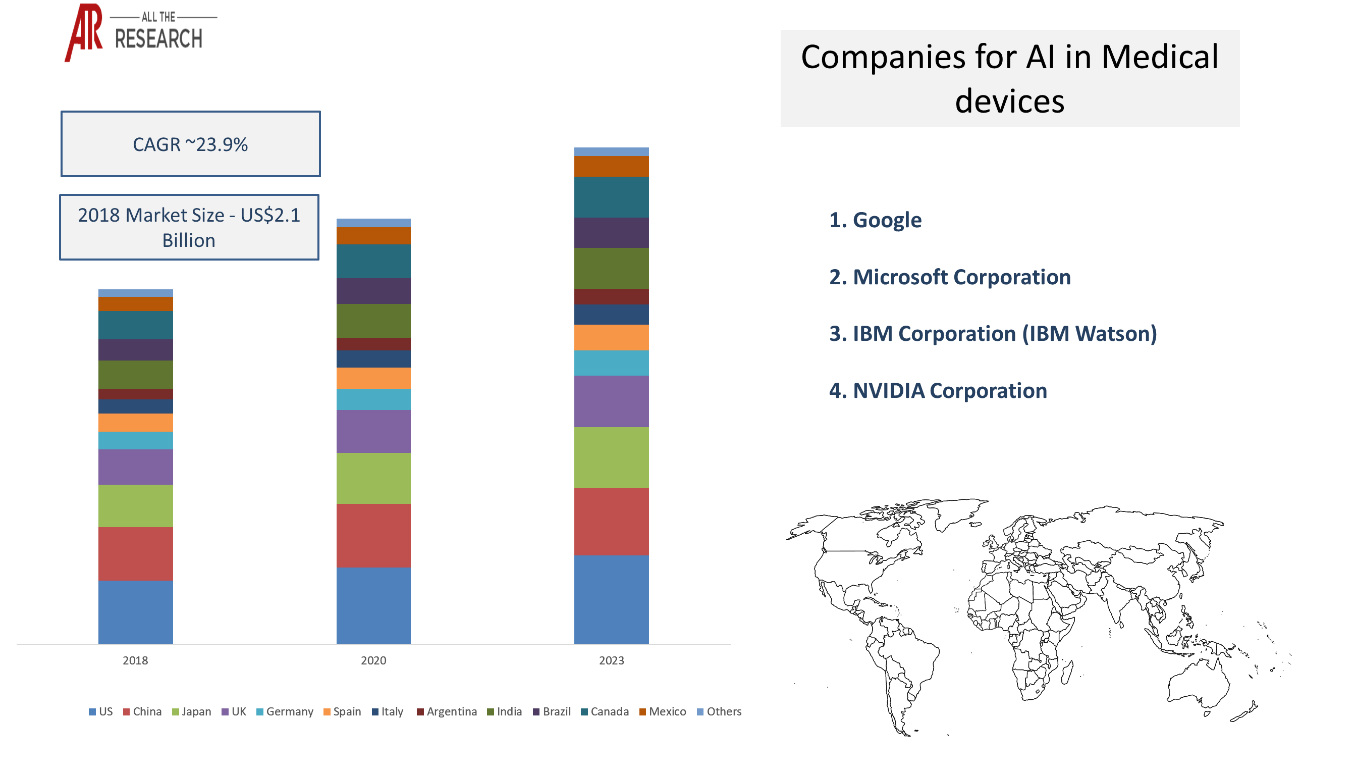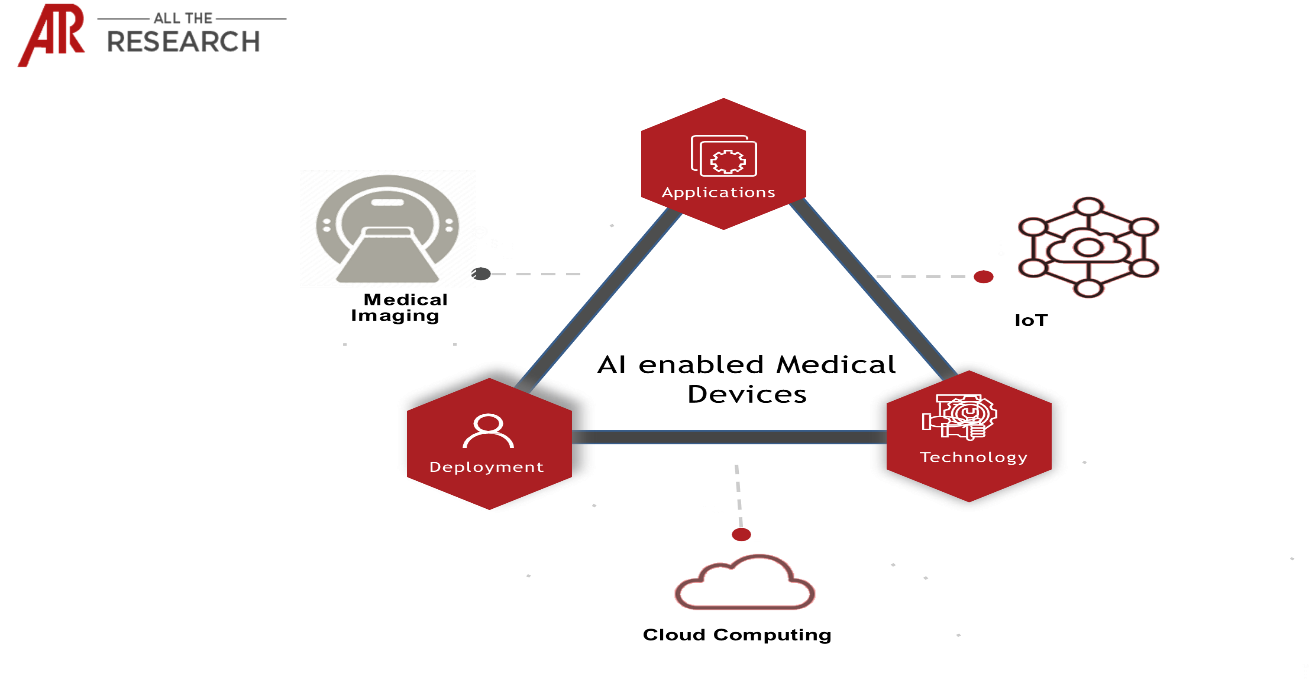The Artificial Intelligence Based Medical Device Market Ecosystem is Expected to Grow at a CAGR of 25.7% by Forecast Year 2027. The medical devices market, which was valued at around US$ 430 billion in 2018, is witnessing rapid evolution due to the integration of various advanced technologies, AI being one of them. The adoption of AI enabled medical devices have long been heralded as the future of diagnosis and treatment. However, it was only in April 2018, the first medical device, called IDx-DR that can autonomously use AI for the diagnosis of a medical condition, approved by the U.S. FDA. The IDx-DR uses an AI algorithm for the screening of diabetic retinopathy and the results obtained do not require an additional review by a specialized clinician. The AI enabled medical devices ecosystem is on the cusp with the increasing number of product approvals.
It is estimated that around 1 in 3 adults is suffering from multiple chronic conditions (MCCs). The increasing burden of chronic diseases such as diabetes, asthma, hypertension, etc., is one of the major factors that is increasing healthcare costs worldwide. To bring about an improvement in the quality of life of chronically ill patients and lower healthcare costs are thus some important goals for the healthcare bodies across the globe. AI integrated medical devices help in the efficient and effective monitoring of these conditions. Diabetes is one such condition where the use of AI-based medical devices is increasing.
In 2017, Medtronic launched an AI-based insulin pump the MiniMed 670G system in the U.S. The system automatically delivers baseline level of insulin to stabilize glucose levels continuously. In 2016, the company also launched its Sugar.IQ app, a personal assistant used for the continuous monitoring of glucose levels. The app, which has been developed in collaboration with IBM Watson, uses data from Medtronic’s insulin pumps and CGMs. Machine Learning algorithms that use Guardian Connect CGM’s data have shown 90% accuracy for predicting hypoglycemic events in a 2-hour window period.
AI-based medical imaging systems is another space where many leading players are investing. GE healthcare, a global leader in the medical imaging devices market, is leveraging AI to improve the accuracy and speed of CT scans, along with its partner NVIDIA. As medical devices undergo changes, it is expected that the regulatory bodies respond to these changes and upgrade/alter the way such devices are approved. In 2019, the U.S. FDA has published changes in its approval process for AI/ML-based medical devices and for software as a Medical Device (SaMD).
Figure 1: Ecosystem Snapshot: AI enabled Medical Devices Ecosystem

Figure 2: Artificial Intelligence: Segmentation of AI enabled Medical Devices Ecosystem
|
Application |
Technology |
Deployment |
|
Treatment |
Predictive Maintenance/Self Diagnostics |
Cloud |
|
Diagnosis & Monitoring |
Machine learning |
On-Premise |
|
Deep learning |
||
|
NLP |
||
|
Computer Vision |
||
|
Predictive Analytics |
||
|
Others |
Global AI enabled Medical Devices Ecosystem
The AI enabled Medical devices ecosystem is expected to grow with a double digit CAGR during the forecast period. The growth of AI enabled Medical Devices Ecosystem is mainly driven by increasing investments from both established players and start-ups. In April 2019, PathAI, a provider of AI-powered technology for pathology, raised US$ 60 million in a series B funding, which was further increased by an US$ 15 million investment from Bristol-Myers Squibb and Merck's Global Health Innovation Fund.
Another medical imaging start-up Aidoc raised US$ 27 million funding in 2019. The company’s product is a software that can scan and detect issues in medical images more quickly. Increasing healthcare costs and the potential of AI to help bring them down are driving the growth of the AI enabled medical devices ecosystem. However, rising concerns regarding the security of patient data may hamper the growth of the market to some extent.
Figure 3 – Market Statistics Glimpse: AI enabled Medical Devices Ecosystem

There are many trends that are having an impact on the market forecast. These, when evaluated from a company’s perspective, can drive growth. Our numerous consulting projects have generated sizeable synergies across all regions and all sizes of companies.
The major players operating in the global AI enabled Medical Devices Ecosystem are as follows:
|
Company |
Ecosystem Positioning |
Total Revenue (2018) |
Industry |
Region |
|
|
Technology Provider |
US$ 136.81 bn |
Artificial Intelligence |
Global |
|
Apple Inc. |
Technology Provider |
US$ 265.60 bn |
Artificial Intelligence |
Global |
|
Microsoft Corporation |
Technology Provider |
US$ 110.36 bn |
Artificial Intelligence |
Global |
|
IBM Corporation |
Technology Provider |
US$ 79.6 bn |
Artificial Intelligence |
Global |
|
NVIDIA Corporation |
Technology Provider |
US$ 9.71 bn |
Artificial Intelligence |
Global |
Very few markets have the interconnectivity with other markets like AI. Our Interconnectivity module focuses on the key nodes of heterogeneous markets in detail. Cloud computing, Internet of Things, and Medical Imaging markets are some of our key researched markets.
Figure 4 – Artificial Intelligence Major Interconnectivities Ecosystem

A Glance on the Global AI enabled Medical Devices Ecosystem Trends:
|
Trends |
Application |
Technology |
Deployment |
Impact |
|
There is an increase in the use of machine learning techniques in blood glucose monitoring devices, in order to deliver efficient diabetes care services through mobile devices. Machine learning is used to analyze the data fed on the cloud that enables patients to make informed decisions for managing their glucose levels. |
Diagnosis |
Machine Learning |
|
1.61% |
|
The increasing use of deep learning-based system for detecting diabetic retinopathy, in order to provide faster and accurate diagnosis of diabetes-related progressive eye disease. AI technology helps identify the patients that are likely to have diabetic retinopathy, which in turn, will require evaluation by eye care providers. |
Diagnosis |
Deep Learning |
|
2.65% |
|
Computer vision and machine learning technologies are used to detect skin cancer by clicking photos through mobile devices. The algorithm recognizes specific features such as the color, shape, and size of lesions in order to identify higher risk of melanoma. Further, the photos of lesions are categorized by the algorithm based on risks. |
Diagnosis |
Machine Learning |
|
2.52% |

Ask for free product review call with the author

Share your specific research requirements for a customized report

Request for due diligence and consumer centric studies

Request for study updates, segment specific and country level reports
Ecosystem Report – Table of Content
